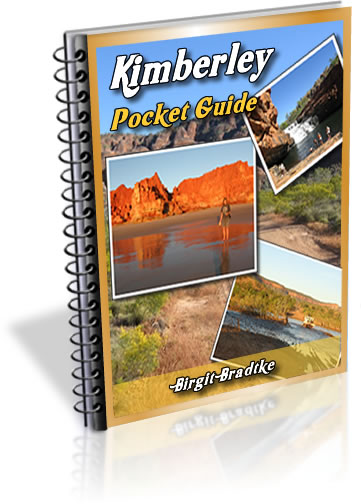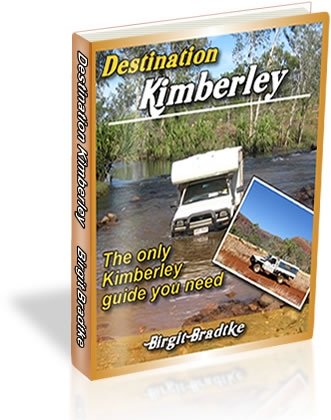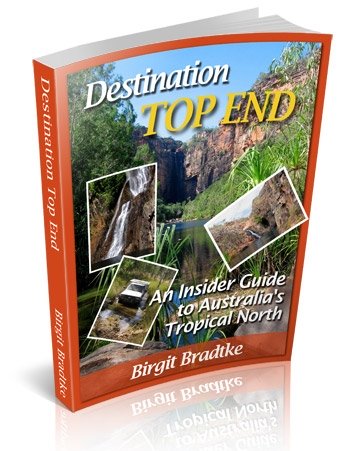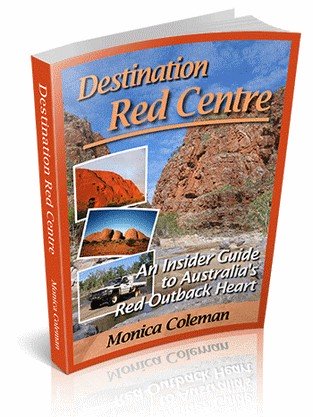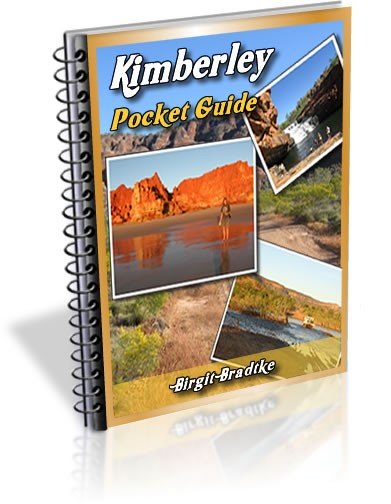Kooljaman at Cape Leveque
Kooljaman Resort at Cape Leveque is sometimes called a luxury resort, sometimes a wilderness camp.
It might sound like a contradiction but the Cape Leveque resort is both.
(Thank god, or I wouldn't be able to afford it...)
Note: Sadly, Kooljaman Resort unexpectedly closed, from November 1, 2021.
It is is not known if or when it will reopen.
(I'd say, eventually it will, but certainly not in 2022.)
For more information see newsletter issue #97.
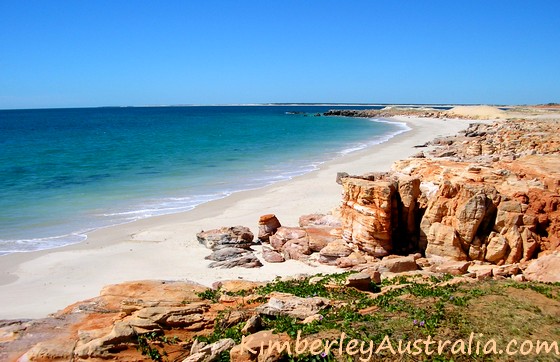
Kooljaman is not only one of the most isolated resorts in Australia, it is also one of the most beautiful. It's good to see that the resort does the place justice, rather than spoil it like the tourism industry so often does.
The Beaches Of Kooljaman Wilderness Camp
The Broome area is famous for its beaches and Cable Beach, officially one of the world's top beaches, gets marketed to death.
In my opinion the beaches at Cape Leveque's Kooljaman Resort beat Cable Beach hands down. Have a look at the pictures below...
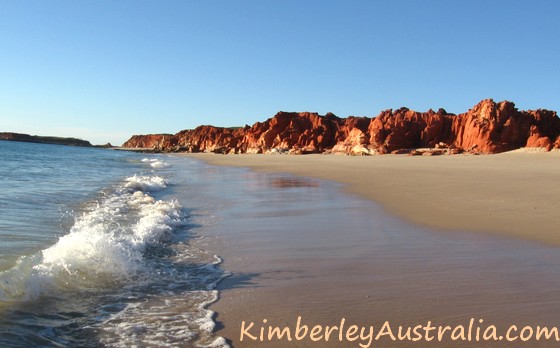 Western Beach at high tide
Western Beach at high tide
At Kooljaman you can watch the sun rising out of the ocean, from your bed if you like!
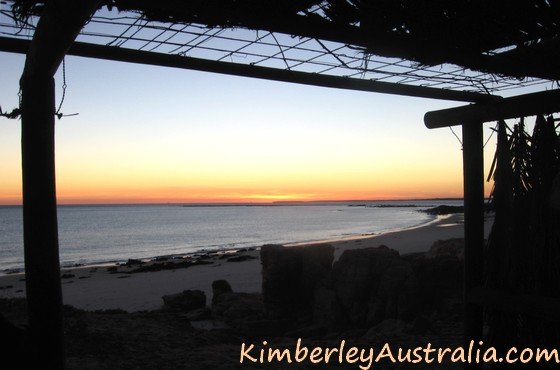 Kooljaman Resort sunrise view from a beach shelter
Kooljaman Resort sunrise view from a beach shelter
And on the other side of the Cape you can watch the sun melt back into the ocean at night...
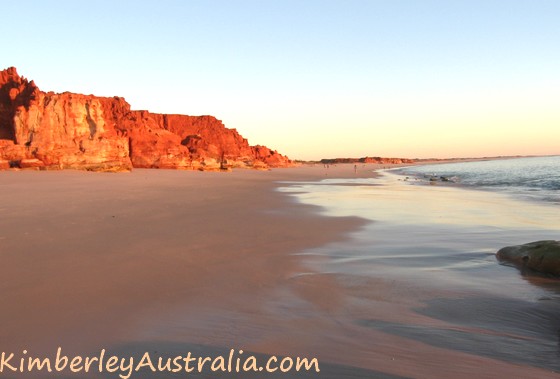 Sunset on the Western Beach
Sunset on the Western Beach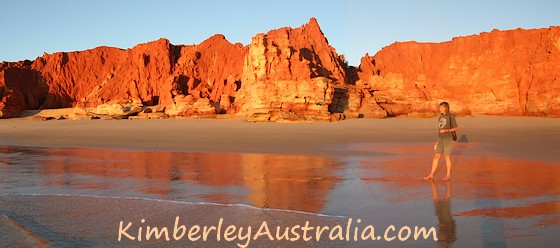
Go for a beach walk in the morning. Kilometres and kilometres of powdery sand, interspersed with rocky sections, but rarely another foot print...
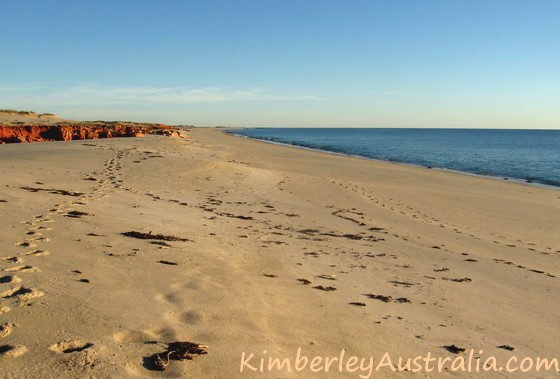 These are our footprints! Nobody else was here.
These are our footprints! Nobody else was here.
(Ok, that depends on the time of the year. It was true for most of the year when I first wrote this page. Now, over ten years later, things look a bit different at Kooljaman. Still, the resort can only accommodate so many people, so the beaches never get crowded.)
You can also swim in the crystal clear ocean year round without worrying about crocodiles or jelly fish.
If you know anything about the Kimberley you know how rare that is. No, not the clear water. The fact that you can always swim in it!
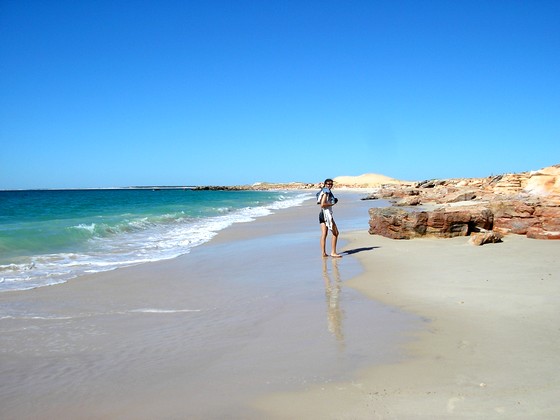 High tide at Eastern Beach
High tide at Eastern Beach
(Hm. again, I first wrote this 10 years ago. It is still true. You don't need to worry about jelly fish or crocodiles at these beaches. But there have been occasional crocodile sightings. And even though those crocodiles do not pose any danger, people do panic, so the resort staff closed the beach temporarily, usually for a few hours.
You can read more about those developments here.
And learn more about saltwater crocodiles here.)
Between July and October you can view migrating humpback whales, which pass in viewing distance from the beaches.
You can snorkel at the rocks between the beaches, or put your boat in the water and go fishing. The fishing is excellent!
The Aboriginal owners of the land can take you to catch some delicious mud crabs, give you a lesson in spear fishing or teach you about traditional bushfoods and medicine.
If you are a bit adventurous and like exploring go down to Hunter Creek. But beware of crocodiles at the creek. And don't get bogged here, the sand is very soft...
(Sigh. These days you are only allowed to visit Hunter Creek with an indigenous guide.)
Join a fishing tour or a boat tour if you don't know enough about boats or fishing to go on your own. (Kooljaman even offers some scenic flights to the Buccaneer Archipelago.)
Then you can camp right on the beach and have a fire at night to cook the day's catch. Or ask the kitchen staff at the excellent restaurant to cook it for you!
When you've had enough of beach life for a while go for a stroll along the board walk that leads over the top of the hills, past the lighthouse, from one side of Cape Leveque to the other.
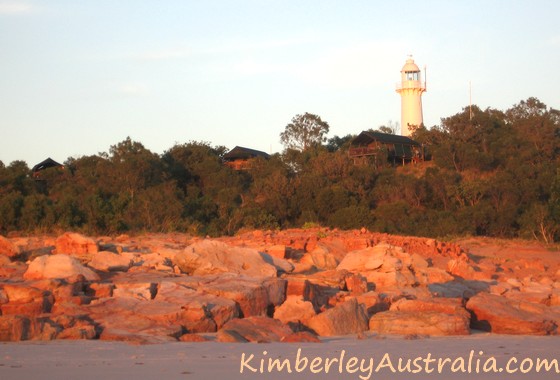 Luxury safari tents barely visible in the vegetation of Cape Leveque
Luxury safari tents barely visible in the vegetation of Cape Leveque
Learn a bit about the ecology, the plants and animals of the peninsula, and about how the Aboriginals use them.
There are also very interesting stories and old letters and newspaper articles, from and about the previous Cape Leveque lighthouse keepers. What a life they must have had, so far away from everything. Back then there was of course no tourism...
Which brings me to the only downside of the place...
During the main season it is always fully booked and awfully busy. So decide if you can handle that or not. If you can, make sure you book well ahead!!
(And if you can't: There are many other places on the Dampier Peninsula that offer the same: unspoiled nature, stunning beaches, great fishing and Aboriginal culture. They just aren't as big and not as well known yet.)
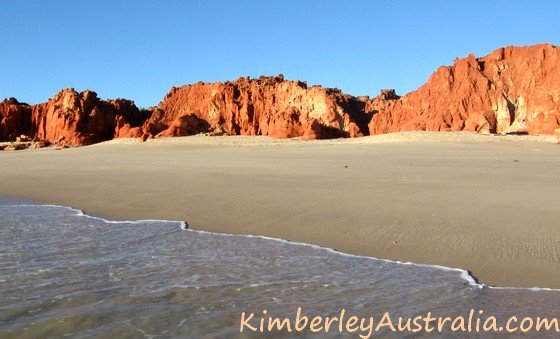 Late afternoon at Western Beach
Late afternoon at Western BeachGetting There
The 204 km drive from Broome can take up to three hours if you drive straight through. Only the first half of the Cape Leveque Road is still unsealed. Even that section is a lot better these days than it was years ago, but because of the heavy use it still gets horribly corrugated. Once you reach the Aboriginal owned country further north the road is sealed and excellent.
Sealing of the remaining 90 km started in May 2018 and is expected to be completed in three to four years.
Cape Leveque has a small airport and you can book fly-in day tours or longer stays from Broome or Derby. Road transfers and 4WD tours are also available. Drive-in day visitors have to pay a $10 admission fee.
During the wet season (November-April) the road may get closed due to wet conditions.
Accommodation at Kooljaman Resort
Kooljaman Resort is jointly owned by the Cape Leveque Aboriginal communities One Arm Point and Djarindjin. Every member of the community is a shareholder in the resort and all the profits go back into those Aboriginal communities.
They have a lot of conservation projects going on, like tree planting or building board walks to protect the dunes. The construction of the camp itself also followed low impact environmental guidelines.
The accommodation options at Kooljaman Resort are a bit unusual (unusual for a resort, not for this part of the world) and there is a whole range. As I said, wilderness camp and luxury resort and everything in between. And somehow it works.
At the luxury end there are the safari tents, which of course aren't just tents...
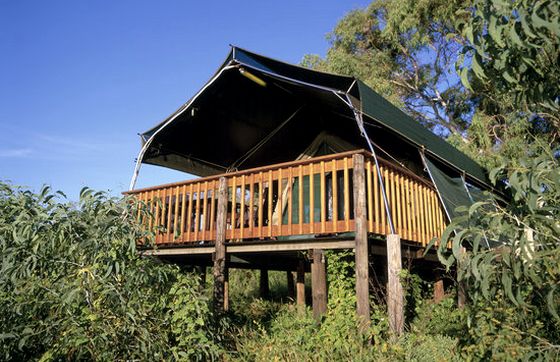
These "tents" are sophisticated structures built into the steep hillside, so the verandas are on high stilts and overlook the beaches and the ocean.
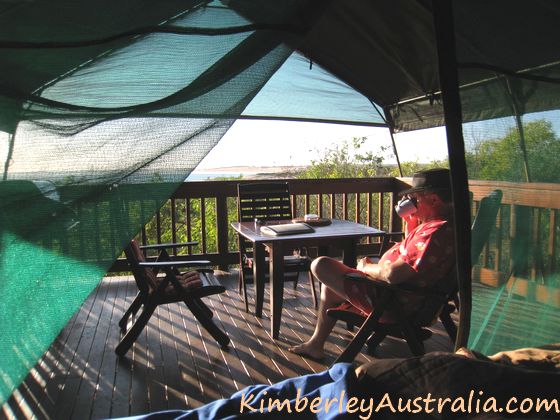 View from inside the tent. (© Photo by reader Maurice.)
View from inside the tent. (© Photo by reader Maurice.)
They are serviced and have a little kitchen and ensuite, all pretty flash.
Initially I looked at them with some envy. No way could I afford staying there.
No, we rented what's available at the other end of the scale: a palm frond thatched beach shelter.
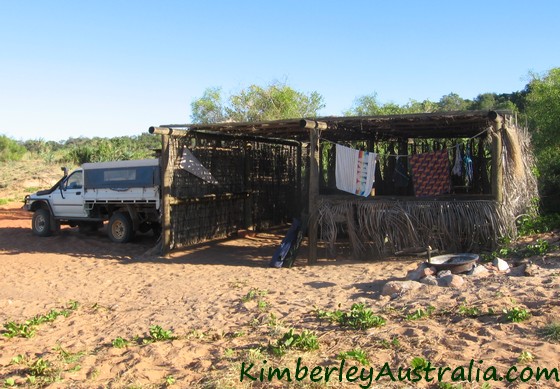
Inside you can unroll your swag or pitch your tent next to the wooden benches and table. Each shelter also has a fire place.
The beach shelters are located right above the Eastern Beach.
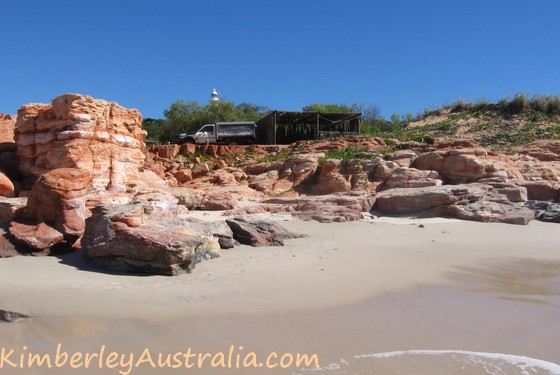 High tide! Usually there is a lot more beach there. :-)
High tide! Usually there is a lot more beach there. :-)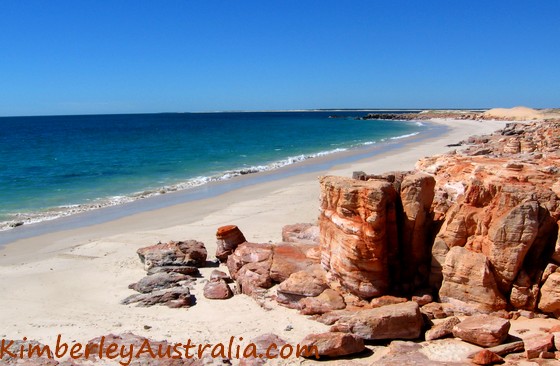 The view from our beach shelter
The view from our beach shelter
And I assure you, after spending a few nights there, as far as I'm concerned the rich people can keep their safari tents, thank you.
You have many other options for accommodation at Kooljaman: units, log cabins and a normal camp ground. (No large camping vehicles and caravans in that one!)
If you don't have any camping equipment you can rent one of their dome tents, permanent structures with double beds, a solid floor and a little wooden veranda. The only drawback is that, because they are powered, they are all pretty close together.
There is also a basic store and a restaurant that offers take-away.
Also on the topic of power: they don't have much of it. Just a bit of solar and a generator as back up for the restaurant. Therefore power hungry appliances like air-cons or freezers are not allowed to be used. You can also leave the hair dryer, toaster and microwave at home. :-)
If you bring your own tent, swag or sleeping bag you can rent a beach shelter and have the illusion that you are the only person at Kooljaman. (At least in the off season you can.)
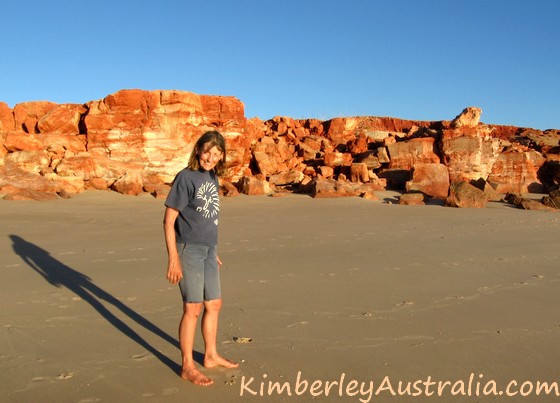 My mother, happy to be all alone at Kooljaman :)
My mother, happy to be all alone at Kooljaman :)
One more thing: during peak season Kooljaman is booked out many months in advance. So book ahead or you will miss out!
You can do so or read more about Kooljaman on their own website.
Other resorts and bush camps on the Dampier Peninsula
Travelling to the Kimberley?
The FREE Kimberley Pocket Guide
A great introduction to travel in the Kimberley region and along the Gibb. This free resource will answer all the questions you might have in the early stages of planning a trip.
Destination Kimberley
The full Kimberley travel guide shows you how to make the most of your adventure at Australia's last frontier. Destination Kimberley includes the most detailed and most current guide to the Gibb River Road available anywhere. Also called "The Bible" by its readers.
Travelling to the Northern Territory?
Destination Top End offers the same comprehensive, detailed insider information for the tropical regions of the Northern Territory. Be the best informed traveller in the Kakadu, Litchfield and Katherine Gorge national parks and beyond!
A must have if you travel to or from Darwin.
NEW! Destination Red Centre is the latest addition in this popular series. Monica Coleman takes you through Australia's red Outback heart, offering all the detail and insider tips that you have come to know and love about our guides. With special emphasis on Aboriginal communities and culture.
A must have if you travel to or from Alice Springs/Uluru.
